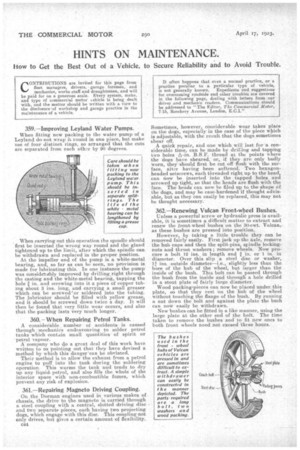HINTS ON MAINTENANCE.
Page 28

If you've noticed an error in this article please click here to report it so we can fix it.
How to Get the Best Out of a Vehicle, to Secure Reliability and to Avoid Trouble.
CONTRIBUTIONS are invited for this page from fleet managers, drivers, garage foremen, and mechanics, works staff and draughtsmen, and will be paid for on a generous scale. Every system, make, and type of commercial motor vehicle is being dealt with, and the matter should be written with a view to the disclosure-of workshop and garage practice in the maintenance of a vehicle. It often happens that even a normal practice, or a practice peculiar to a particular type of vehicle, is not generally known. Expedients and suggestions for overcoming roadside arid other troubles ass covered in the following page, dealing with letters from our driver and mechanic readers. Communications should be addressed to "-The Editor, The Commercial Motor, 7-15, Ro,sehery Avenue, London, E.C.1."
359.—Improving Leyland Water Pumps.
When fitting new packing to the water pump of a Leyland do 'not Wrap it, round in one piece, but make use of four distinct rings, so arranged that the cuts are separated from each other by 90 degrees.
, When carrying out this operation the spindle should first be inserted the wrong way round and the gland tightened up to the limit, after which the spindle can be withdrawn and replaced in the proper position. At the impeller end of the pump is a white-metal bearing, and, so far as can be seen, no provision is made for lubricating this. In one instance the pump was considerably improved by drilling right through the casting and the white-metal bearing, tapping the hole in. and screwing into it a piece of copper tubing about 3 ins, long, and carrying a small greaser which can be screwed 'or soldered into the tubing. The lubricator should be filled with yellow grease, and it should be screwed down twice a day. It will then be found that very little wear occurs, and also that the packing lasts very much longer.
360. —When Repairing Petrol Tanks.
A considerable, number of accidents is caused through :mechanics endeavouring to solder petrol tanks which contain small quantities of spirit or • petrol vapour.
A company who do a great deal of this work have written to us pointing out that they have devised a method by which this danger 'can be obviated. Their method is to allow the exhaust from a petrol engine to puff into the tank during the soldering operation. This warms the tank and tends to dry up any liquid petrol, and also fills the whole of the interior space with non-combustible fumes, which prevent any risk of explosion.
-361.—Repairing Magneto Driving Coupling.
On the Dorman engines used in various makes of chassis, the drive to the magneto is carried through a steel coupling with a central, slotted driving disc and two separate pieces, each having two projecting dogs, which engage with this disc. This coupling not only drives, but gives a certain amount of flexibility.
044
Sometimes, however, considerable Wear takes plaCe on the dogs, especially in the case of the piece which is adjustable, with the result that the dogs sometimes shear off.
A quick repair, and one which will last fora considerable time, can be made by drilling and tapping two holes 4in. B.S.F. thread at the points where the dogs have sheared, or, if they are. only badly worn, they should first be cut off flush with the surface, after having been softened. Two hexagonheaded setscrews, each threaded right up to the head, can now be inserted into the tapped holes and screwed up tight, so that the heads are flush with the face. The heads can now be filed up to the shape of the dogs, and may be case-hardened if thought advisable, but as they can easily be replaced, this may not he thought necessary.
362.—Renewing Vulcan .Front-wheel Bushes.
Unless a powerful screw or hydraulic press is available, it is sometimes a difficult matter to extract and renew the front-wheel bushes on the 30-cwt. Vulcan, as these-bushes are pressed into position.
However, by taking a little trouble they can be removed fairly easily. First jack up the axle, remove the hub caps and then the split-pins, spindle lockingnuts and thrust washers ; remove wheels. Now pro
cure a bolt 12 ins, in length and in. or 1 in. in diameter. Over this slip a steel disc or washer, 1,1 ins, outside diameter—i.e., slightly less than the bore of the hub of the wheel, but larger than the inside of the bush. This bolt can be passed through the 'bush from the inside and through a hole drilled in a stout plate of fairly large diameter.
Wood packingspieces can now be placed under, this plate, so that they rest on the hub of the wheel without touching the flange of the bush. By running a nut down the bolt and against the plate the bush can now easily be withdrawn.
New bushes can be fitted in a like manner, using the large plate at the other end of the bolt. The time taken to remove the bushes and to fit new ones to' both front wheels need not exceed 'three hours.






























